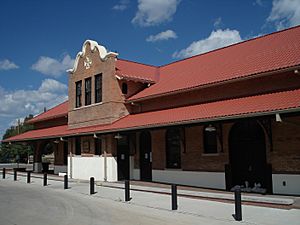Las Vegas, New Mexico facts for kids
Quick facts for kids
Las Vegas, New Mexico
|
|
|---|---|
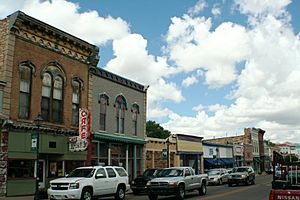
Old Town Las Vegas, New Mexico
|
|
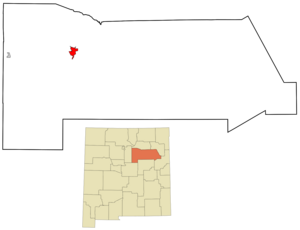
Location of Las Vegas, New Mexico
|
|
| Country | United States |
| State | New Mexico |
| County | San Miguel |
| Government | |
| • Type | Mayor-council government |
| Area | |
| • Total | 8.62 sq mi (22.34 km2) |
| • Land | 8.62 sq mi (22.33 km2) |
| • Water | 0.00 sq mi (0.01 km2) |
| Elevation | 6,441 ft (1,963 m) |
| Population
(2020)
|
|
| • Total | 13,166 |
| • Density | 1,527.02/sq mi (589.59/km2) |
| Time zone | UTC−07:00 (Mountain (MST)) |
| • Summer (DST) | UTC−06:00 (MDT) |
| ZIP Codes |
87701, 87745
|
| Area code(s) | 505 |
| FIPS code | 35-39940 |
| GNIS feature ID | 2411631 |
| Website | lasvegasnm.gov |
Las Vegas, often called Vegas, is a city in New Mexico, United States. It is the main city of San Miguel County.
Long ago, there were two separate towns, both named Las Vegas. One was West Las Vegas, known as "Old Town." The other was East Las Vegas, called "New Town." The Gallinas River runs between them. Even today, they have different styles and separate school districts.
In 2020, about 13,166 people lived in Las Vegas. The city is located in a central part of New Mexico. It is about 110 miles south of Raton and 65 miles east of Santa Fe.
Contents
History of Las Vegas, New Mexico
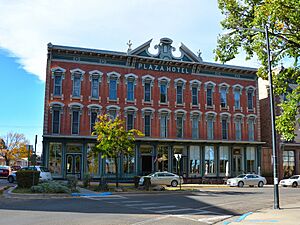
Las Vegas was started in 1835. A group of settlers received land from the Mexican government. The town was designed like traditional Spanish towns. It had a central plaza (a town square) surrounded by buildings. These buildings could be used for protection if needed.
Las Vegas quickly became a busy stop on the Santa Fe Trail. This trail was a major trade route. In 1846, during the Mexican–American War, Stephen W. Kearny spoke at the Plaza. He announced that New Mexico was now part of the United States. In 1847, the town saw the Battle of Las Vegas. This was part of a larger uprising by local people against the U.S. occupation.
In 1877, Las Vegas College was founded by Italian Jesuits. This college later moved to Denver and changed its name to Regis University.
The Railroad Arrives
The Atchison, Topeka and Santa Fe Railroad reached Las Vegas on July 4, 1879. The railroad built its station about a mile east of the old Plaza. This created a new, separate town called "New Town." This was similar to what happened in other Old West cities like Albuquerque.
During the railroad era, Las Vegas grew very fast. It became one of the biggest cities in the American Southwest. Las Vegas had many modern things for its time. These included an electric street railway and a Carnegie library. It also had the Castañeda Hotel, a famous hotel. The New Mexico Normal School (now New Mexico Highlands University) was also built here.
After the 1950s, the railroad industry changed. The city's population has stayed about the same since then. Even though the two towns are now one city, they still have separate school districts. These are Las Vegas City Schools and West Las Vegas School District.
Cowboy Reunions in Las Vegas
From 1915 to 1931, and then again from 1939, Las Vegas held annual "Cowboys' Reunions." Their motto was, "Git Fer Vegas, Cowboy!" Ranching families and cowboys organized these events. The reunions celebrated the ranching life in northern New Mexico.
These yearly events included fun activities. There were pie-eating contests, barbecues, and parades. There were also banquets, balls, and "ranch rodeos." Famous people came to these events. Movie stars like Tom Mix and artists like Randall Davey visited. Later, well-known cowhands took part in the rodeos. These reunions showed the importance of ranching in the area. They attracted huge crowds for four days of events.
Famous Old West Figures
When the railroad arrived in 1879, it brought new businesses and people. Some of these new residents were not so good. The eastern part of the town became a bit wild. Many famous people from the Old West visited Las Vegas.
These included:
- The dentist Doc Holliday and his girlfriend Big Nose Kate
- Dave Rudabaugh
- Jesse James
- Billy the Kid
- Wyatt Earp
- Mysterious Dave Mather
- Hoodoo Brown
A historian named Ralph Emerson Twitchell once said that Las Vegas had many famous and sometimes dangerous people.
Geography and Climate
Las Vegas covers about 7.5 square miles (19.4 square kilometers) of land.
The city has a cold semi-arid climate. This means it is generally dry, but not a desert. It has cold winters and warm summers.
| Climate data for Las Vegas, New Mexico, 1991–2020 normals, extremes 1983–present | |||||||||||||
|---|---|---|---|---|---|---|---|---|---|---|---|---|---|
| Month | Jan | Feb | Mar | Apr | May | Jun | Jul | Aug | Sep | Oct | Nov | Dec | Year |
| Record high °F (°C) | 72 (22) |
74 (23) |
80 (27) |
85 (29) |
92 (33) |
98 (37) |
99 (37) |
95 (35) |
94 (34) |
88 (31) |
81 (27) |
74 (23) |
99 (37) |
| Mean maximum °F (°C) | 64.0 (17.8) |
65.7 (18.7) |
72.8 (22.7) |
77.2 (25.1) |
86.2 (30.1) |
92.4 (33.6) |
93.0 (33.9) |
91.0 (32.8) |
86.7 (30.4) |
81.4 (27.4) |
71.8 (22.1) |
66.3 (19.1) |
94.5 (34.7) |
| Mean daily maximum °F (°C) | 50.1 (10.1) |
52.8 (11.6) |
60.4 (15.8) |
67.2 (19.6) |
75.0 (23.9) |
84.7 (29.3) |
85.2 (29.6) |
84.2 (29.0) |
78.6 (25.9) |
69.2 (20.7) |
58.7 (14.8) |
50.2 (10.1) |
68.0 (20.0) |
| Daily mean °F (°C) | 30.7 (−0.7) |
33.6 (0.9) |
40.4 (4.7) |
47.7 (8.7) |
55.3 (12.9) |
64.9 (18.3) |
68.2 (20.1) |
67.2 (19.6) |
60.3 (15.7) |
49.3 (9.6) |
38.9 (3.8) |
30.8 (−0.7) |
48.9 (9.4) |
| Mean daily minimum °F (°C) | 11.3 (−11.5) |
14.4 (−9.8) |
20.3 (−6.5) |
28.2 (−2.1) |
35.7 (2.1) |
45.2 (7.3) |
51.2 (10.7) |
50.2 (10.1) |
42.1 (5.6) |
29.4 (−1.4) |
19.0 (−7.2) |
11.5 (−11.4) |
29.9 (−1.2) |
| Mean minimum °F (°C) | −3.2 (−19.6) |
−0.6 (−18.1) |
6.7 (−14.1) |
17.1 (−8.3) |
24.2 (−4.3) |
34.9 (1.6) |
43.2 (6.2) |
41.9 (5.5) |
30.0 (−1.1) |
15.0 (−9.4) |
3.0 (−16.1) |
−5.1 (−20.6) |
−11.3 (−24.1) |
| Record low °F (°C) | −22 (−30) |
−32 (−36) |
−9 (−23) |
10 (−12) |
11 (−12) |
28 (−2) |
33 (1) |
30 (−1) |
20 (−7) |
−3 (−19) |
−16 (−27) |
−32 (−36) |
−32 (−36) |
| Average precipitation inches (mm) | 0.42 (11) |
0.45 (11) |
0.56 (14) |
0.70 (18) |
1.49 (38) |
1.36 (35) |
3.19 (81) |
3.12 (79) |
2.43 (62) |
1.69 (43) |
0.57 (14) |
0.74 (19) |
16.72 (425) |
| Average snowfall inches (cm) | 3.0 (7.6) |
3.8 (9.7) |
2.8 (7.1) |
1.3 (3.3) |
0.0 (0.0) |
0.0 (0.0) |
0.0 (0.0) |
0.0 (0.0) |
0.0 (0.0) |
1.4 (3.6) |
4.0 (10) |
5.7 (14) |
22.0 (56) |
| Average precipitation days (≥ 0.01 in) | 2.0 | 2.3 | 2.2 | 2.8 | 4.3 | 4.9 | 9.1 | 9.5 | 5.6 | 3.4 | 2.8 | 2.1 | 51.0 |
| Average snowy days (≥ 0.1 in) | 1.7 | 1.5 | 1.1 | 0.4 | 0.0 | 0.0 | 0.0 | 0.0 | 0.0 | 0.3 | 1.3 | 1.6 | 7.9 |
| Source 1: NOAA | |||||||||||||
| Source 2: National Weather Service | |||||||||||||
Recent Natural Events
In 2022, Las Vegas and nearby areas faced a very large wildfire. This fire was called the Calf Canyon/Hermits Peak Fire. It burned over 341,000 acres (1,380 square kilometers). This made it the biggest fire ever recorded in New Mexico's history.
Population and People
| Historical population | |||
|---|---|---|---|
| Census | Pop. | %± | |
| 1890 | 2,312 | — | |
| 1900 | 3,552 | 53.6% | |
| 1910 | 3,755 | 5.7% | |
| 1920 | 4,304 | 14.6% | |
| 1930 | 4,719 | 9.6% | |
| 1940 | 5,941 | 25.9% | |
| 1950 | 7,494 | 26.1% | |
| 1960 | 7,790 | 3.9% | |
| 1970 | 7,528 | −3.4% | |
| 1980 | 14,322 | 90.2% | |
| 1990 | 14,753 | 3.0% | |
| 2000 | 14,565 | −1.3% | |
| 2010 | 13,753 | −5.6% | |
| 2020 | 13,166 | −4.3% | |
| 2021 (est.) | 13,157 | −4.3% | |
| U.S. Decennial Census | |||
In 2000, there were about 14,565 people living in Las Vegas. The city had 5,588 households. About 3,559 of these were families.
The population of Las Vegas was highest in 1990, with 14,753 people. By 2019, the number of people had gone down to about 12,919.
About 26.4% of the people in the city were under 18 years old. About 12.8% were 65 years or older. The average age in the city was 34 years.
Libraries and Museums
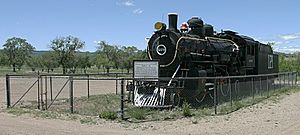
Thomas C. Donnelly Library
New Mexico Highlands University, founded in 1893, has the Thomas C. Donnelly Library. This library helps students and teachers with their studies and research. It has almost 200,000 books. The library was made much bigger, growing from 23,700 to 53,500 square feet.
Carnegie Library
Las Vegas's Carnegie Library was built in 1904. It is the only Carnegie Library still standing in New Mexico. Andrew Carnegie, a rich businessman, donated $10,000 to build it. The library looks like Monticello, the home of Thomas Jefferson. It is in the middle of a park, surrounded by old Victorian-style homes.
City of Las Vegas Museum & Rough Rider Memorial
The City of Las Vegas Museum & Rough Rider Memorial opened in 1940. It was created because Teddy Roosevelt's Rough Riders regiment chose Las Vegas as their official reunion home. The Rough Riders were a famous group of soldiers from the Spanish–American War. Their first reunion was held in Las Vegas in June 1899.
The museum is free to visit. It has many items, photos, and papers from the Rough Riders. It also tells the story of Las Vegas. You can learn about the Santa Fe Trail and how New Mexico grew. The museum also shows Native American pottery, old household items, and ranching tools.
Historic Architecture
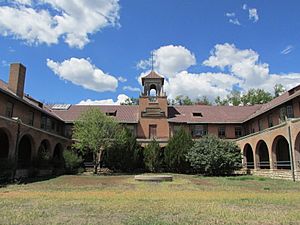
Las Vegas has many historic buildings. Over 900 of them are listed on the National Register of Historic Places. Many of these are old railroad-era homes and businesses. Some have been fixed up, and others are waiting to be restored.
Here are some famous buildings in the city:
- Dr. H.J. Mueller House: Built in 1881, it's now a Bed and Breakfast. It has a unique octagonal tower.
- Plaza Hotel: Built in 1881, this hotel hosted the first reunion of Teddy Roosevelt's Rough Riders in 1899.
- Old City Hall: This was New Mexico's first city building, finished in 1892.
- Louis Fort House: A beautiful Queen Anne style house built in 1895.
- Masonic Temple: A strong Richardsonian Romanesque building from 1895.
- Castañeda Hotel: A mission-style hotel built in 1898 by the famous Harvey House company.
- Carnegie Library: Built in 1903, it sits in Carnegie Park and looks like Monticello.
Education in Las Vegas
Public Schools
Las Vegas has two public school districts:
- Las Vegas City Schools serves the east side of the city.
- West Las Vegas School District serves the west side.
The city has two main high schools:
- Robertson High School
- West Las Vegas High School
Colleges and Universities
Las Vegas is home to New Mexico Highlands University. This university is important for training teachers in New Mexico. It is known for its science, drama, art, and foreign language programs. The art department was very famous from the 1950s to the 1970s. The university also has sports teams that play in NCAA II.
North of Las Vegas is Luna Community College. Also nearby, in Montezuma, New Mexico, is the United World College. This is a two-year international high school. It is also used for teacher training for the International Baccalaureate Diploma Programme.
Transportation
Trains
The Las Vegas Amtrak Station is a stop for the Southwest Chief train route.
Airport
The Las Vegas Municipal Airport is for smaller planes. It serves single-engine planes, small commercial jets, and helicopters.
Highways
- Interstate 25 runs through Las Vegas.
- Interstate 40 is about 55 miles south, reached by U.S. Route 84.
Bus Service
The city of Las Vegas has a bus service called Meadow City Express. It offers rides when you request them. Also, NMDOT Park and Ride offers bus service from Las Vegas to Santa Fe.
Las Vegas in Movies and TV
Many movies and TV shows have been filmed in and around Las Vegas:
- The 2003 movie Blind Horizon
- Most of the 2007 movie No Country for Old Men by the Coen brothers
- The 2012 A&E TV series Longmire, which is set in Wyoming
- The TV series House of Cards filmed here in 2014 for its third season finale.
- The 1984 movie Red Dawn.
- The 2022 and 2024 Amazon Prime Video TV Series Outer Range.
Local Media
Las Vegas has a newspaper called the Las Vegas Optic. It comes out twice a week, on Wednesdays and Fridays.
The Fort Union Drive-in theater is also located in Las Vegas.
Mayors of Las Vegas
Here is a list of the mayors who have led the city of Las Vegas:
| Mayor | Term start | Term end | |
|---|---|---|---|
| 1 | Eugenio Romero | 1881 | 1883 |
| 2 | John G. Wylie | 1888 | – |
| 3 | Edward Henry | 1890 | – |
| 4 | James S. Duncan | 1892 | 1892 |
| 5 | Andrieus A. Jones | 1893 | 1884 |
| 6 | Major Adin H. Whitmore | 1895 | – |
| 7 | Dr. Frederick Olney | 1897 | – |
| 8 | George P. Money | 1902 | – |
| 9 | Karl D. Goodall | 1903 | – |
| 6 | Dr. Frederick Olney | 1905 | 1907 |
| 10 | Karl D. Goodall | 1911 | – |
| 11 | R. J. Taupert | 1912 | 1913 |
| 12 | Dr. H. M. Smith | 1915 | – |
| 13 | F. O. Blood | 1918 | 1920 |
| 14 | Thomas V. Truder | 1921 | 1934 |
| 15 | Frank W. Condon | 1935 | 1939 |
| 16 | Ivan J. Hilton | 1940 | 1946 |
| 17 | Ivan J. Hilton | 1950 | 1954 |
| 18 | LeRoy S. Wicks | 1956 | 1960 |
| 19 | Frank Olmsted | 1962 | 1966 |
| 20 | Ben Lingnau | 1967 | – |
| 21 | Alfred Nelson | 1968 | – |
| 22 | Fidel "Chief" Gonzales | 1970 | 1975 |
| 23 | Harold K. Brandt | 1977 | – |
| 24 | Max Madrid | 1978 | – |
| 25 | Steve Franken | 1980 | 1985 |
| 26 | Leroy "Huero" Sanchez | 1986 | 1987 |
| 27 | Tony Martinez Jr. | 1988 | 1997 |
| 28 | Matt Martinez | 1998 | 2001 |
| 29 | Henry O. Sanchez | 2002 | 2008 |
| 30 | Tony Marquez | 2009 | – |
| 31 | Alfonso E. Ortiz Jr. | 2010 | 2015 |
| 32 | Tonita Gurule-Giron | 2016 | 2020 |
| 33 | Louie Trujillo | 2020 | 2023 |
| 34 | David Romero | 2023 | present |
Notable People from Las Vegas
Many interesting people have connections to Las Vegas:
- Antonia Apodaca (1923–2020), a talented musician.
- Jesusita Aragón (1908–2005), a well-known midwife.
- S. Omar Barker (1894–1985), a famous cowboy poet and rancher.
- Margaret Herrera Chávez (1912–1992), a painter.
- Ann Nolan Clark (1896–1995), a teacher and writer of children's books.
- Teresa Leger Fernandez (born 1959), an attorney and current member of the U.S. House of Representatives.
- Wally Funk (born 1939), an aviator and astronaut.
- Fabiola Cabeza de Baca Gilbert (1894–1991), an educator, nutritionist, and writer. She even invented the u-shaped fried taco shell!
- Eddie Guerrero (1967–2005), a professional wrestler who wrestled for New Mexico Highlands University.
- Edgar Lee Hewett (1865–1946), an archaeologist who founded the Museum of New Mexico.
- Mari-Luci Jaramillo (1928–2019), an educator and U.S. Ambassador to Honduras.
- Andrieus A. Jones (1862–1927), a school principal, attorney, and former mayor of Las Vegas. He also served as a United States Senator.
- Yetta Kohn (1843–1917), an early businesswoman and successful cattle rancher.
- Margaret Larkin (1899–1967), a writer and musician born in Las Vegas.
- Ray Leger (1925–2009), an educator and member of the New Mexico Senate.
- Pola Lopez (born 1954), an artist.
- George J. Maloof Sr. (1923–1980), a businessman born in Las Vegas.
- Frank Olmstead (1923–2004), a former mayor of Las Vegas and Auditor of New Mexico.
- Patrick Swayze (1952–2009), a famous actor, dancer, and singer. He owned a ranch near Las Vegas.
Images for kids
See also
 In Spanish: Las Vegas (Nuevo México) para niños
In Spanish: Las Vegas (Nuevo México) para niños



